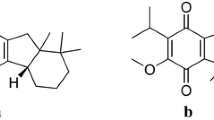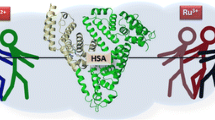Abstract
The interaction between two ruthenium(II) arene complexes of curcumin analogs and human serum albumin (HSA) was systematically investigated by multispectroscopic techniques. The fluorescence spectral results indicated that two complexes quenched the intrinsic fluorescence of HSA through static quenching mode. The quenching constants and the corresponding thermodynamic parameters at different temperatures were calculated. The binding interactions of two complexes with HSA resulted in the complex formation of complex–HSA, and the van der Waals interactions and hydrogen bond interactions played major roles in the complex stabilization. The distances between HSA and two complexes were obtained according to fluorescence resonance energy transfer theory. The site competitive replacement experiments illustrated that two complexes mainly bounded with HSA on site I. The results of synchronous fluorescence spectra, three-dimensional fluorescence spectra, FT–IR spectra, and circular dichroism spectra indicated that the secondary structure of HSA was changed at the present of two complexes. The results of mass spectrometry further validated the binding interaction and the binding number between two complexes and HSA.













Similar content being viewed by others
References
Adams M, Li YQ, Khot H, Kock CD, Smith PJ, Land K, Chibale K, Smith GS (2013) The synthesis and antiparasitic activity of aryl- and ferrocenyl-derived thiosemicarbazone ruthenium(II)–arene complexes. Dalton Trans 42:4677–4685
Demoro B, de Almeida RFM, Marques F, Matos CP, Otero L, Pessoa JC, Santos I, Rodríguez A, Moreno V, Lorenzo J, Gambino D, Tomaz AI (2013) Screening organometallic binuclear thiosemicarbazone ruthenium complexes as potential anti-tumour agents: cytotoxic activity and human serum albumin binding mechanism. Dalton Trans 42:7131–7146
Demoro B, Sarniguet C, Sanchez-Delgado R, Rossi M, Liebowitz D, Caruso F, Olea-Azar C, Moreno V, Medeiros A, Comini MA, Otero L, Gambino D (2012) New organoruthenium complexes with bioactive thiosemicarbazones as co-ligands: potential anti-trypanosomal agents. Dalton Trans 41:1534–1543
Beckford FA, Leblanc G, Thessing Jr J, Shaloski M, Frost BJ, Li L, Seeram NP (2009) Organometallic ruthenium complexes with thiosemicarbazone ligands: synthesis, structure and cytotoxicity of [(η 6-p-cymene)Ru(NS)Cl]+ (NS = 9-anthraldehyde thiosemicarbazones. Inorg Chem Commun 12:1094–1098
Beckford FA, Dourth Jr D, Shaloski M, Didion J, Thessing J, Woods J, Crowell V, Gerasimchuk N, Gonzalez-Sarrías A, Seeram NP (2011) Half-sandwich ruthenium–arene complexes with thiosemicarbazones: synthesis and biological evaluation of [(η 6-p-cymene)Ru(piperonal thiosemicarbazones)Cl]Cl complexes. J Inorg Biochem 105:1019–1029
Stringer T, Therrien B, Hendricks DT, Guzgay H, Smith GS (2011) Mono- and dinuclear (η 6-arene) ruthenium(II) benzaldehyde thiosemicarbazone complexes: synthesis, characterization and cytotoxicity. Inorg Chem Commun 14:956–960
Su W, Zhou Q, Huang YM, Huang QY, Luo LN, Xiao Q, Huang S, Huang CS, Chen R, Qian QQ, Liu LF, Li PY (2013) Synthesis, crystal and electronic structure, anticancer activity of ruthenium(II) arene complexes with thiosemicarbazones. Appl Organometal Chem 27:307–312
Su W, Qian QQ, Li PY, Lei XL, Xiao Q, Huang S, Huang CS, Cui JG (2013) Synthesis, characterization, and anticancer activity of a series of ketone‑N4‑substituted thiosemicarbazones and their ruthenium(II) arene complexes. Inorg Chem 52:12440–12449
Habtemariam A, Melchart M, Fernández R, Parsons S, Oswald IDH, Parkin A, Fabbiani FPA, Davidson JE, Dawson A, Aird RE, Jodrell DI, Sadler PJ (2006) Structure–activity relationships for cytotoxic ruthenium(II) arene complexes containing N,N-, N,O-, and O,O-chelating ligands. J Med Chem 49:6858−6868
Anand P, Thomas SG, Kunnumakkara AB, Sundaram C, Harikumar KB, Sung B, Tharakan ST, Misra K, Priyadarsini IK, Rajasekharan KN, Aggarwal BB (2008) Biological activities of curcumin and its analogues (congeners) made by man and mother nature. Biochem Pharmacol 76:1590–1611
Khan MA, El-Khatib R, Rainsford KD, Whitehouse MW (2012) Synthesis and anti-inflammatory properties of some aromatic and heterocyclic aromatic curcuminoids. Bioorg Chem 40:30–38
Fang XB, Fang L, Gou SH, Cheng L (2013) Design and synthesis of dimethylaminomethyl-substituted curcumin derivatives/analogues: potent antitumor and antioxidant activity, improved stability and aqueous solubility compared with curcumin. Bioorg Med Chem Lett 23:1297–1301
Mosley CA, Liotta DC, Snyder JP (2007) Highly active anticancer curcumin analogues. Adv Exp Med Biol 595:77–103
Ohori H, Yamakoshi H, Tomizawa M, Shibuya M, Kakudo Y, Takahashi A, Takahashi S, Kato S, Suzuki T, Ishioka C, Iwabuchi Y, Shibata H (2006) Synthesis and biological analysis of new curcumin analogues bearing an enhanced potential for the medicinal treatment of cancer. Mol Cancer Ther 5:2563–2571
Valentini A, Conforti F, Crispini A, De Martino A, Condello R, Stellitano C, Rotilio G, Ghedini M, Federici G, Bernardini S, Pucci D (2009) Synthesis, oxidant properties, and antitumoral effects of a heteroleptic palladium(II) complex of curcumin on human prostate cancer cells. J Med Chem 52:484–491
Aliaga-Alcalde N, Marqués-Gallego P, Kraaijkamp M, Herranz-Lancho C, den Dulk H, Görner H, Roubeau O, Teat SJ, Weyhermüller T, Reedijk J (2010) Copper curcuminoids containing anthracene groups: fluorescent molecules with cytotoxic activity. Inorg Chem 49:9655–9663
Caruso F, Rossi M, Benson A, Opazo C, Freedman D, Monti E, Gariboldi MB, Shaulky J, Marchetti F, Pettinari R, Pettinari C (2012) Ruthenium-arene complexes of curcumin: X-ray and density functional theory structure, synthesis, and spectroscopic characterization, in vitro antitumor activity, and DNA docking studies of (p-cymene)Ru(curcuminato)chloro. J Med Chem 55:1072–1081
Bonfili L, Pettinari R, Cuccioloni M, Cecarini V, Mozzicafreddo M, Angeletti M, Lupidi G, Marchetti F, Pettinari C, Eleuteri AM (2012) Arene–RuII complexes of curcumin exert antitumor activity via proteasome inhibition and apoptosis induction. ChemMedChem 7:2010–2020
Antonyan A, De A, Vitali LA, Pettinari R, Marchetti F, Gigliobianco MR, Pettinari C, Camaioni E, Lupidi G (2014) Evaluation of (arene)Ru(II) complexes of curcumin as inhibitors of dipeptidyl peptidase IV. Biochimie 99:146–152
Pettinari R, Marchetti F, Condello F, Pettinari C, Lupidi G, Scopelliti R, Mukhopadhyay S, Riedel T, Dyson PJ (2014) Ruthenium(II)-arene RAPTA type complexes containing curcumin and bisdemethoxycurcumin display potent and selective anticancer activity. Organometallics 33:3709–3715
Wang X, Liu Y, He LL, Liu B, Zhang SY, Ye X, Jing JJ, Zhang JF, Gao M, Wang X (2015) Spectroscopic investigation on the food components–drug interaction: the influence of flavonoids on the affinity of nifedipine to human serum albumin. Food Chem Toxic 78:42–51
Gokara M, Kimavath GB, Podile AR, Subramanyam R (2015) Differential interactions and structural stability of chitosan oligomers with human serum albumin and α-1-glycoprotein. J Biomol Struct Dyn 33:196–210
Wu D, Zhai YM, Yan J, Xu KL, Wang Q, Li YZ, Li H (2015) Binding mechanism of tauroursodeoxycholic acid to human serum albumin: insights from NMR relaxation and docking simulations. RSC Adv 5:11036–11042
Fu JX, Ge YS, Jiang FL, Sun XH, Liu Y, Liu Y (2011) Spectroscopic and molecular modeling studies on the interaction between a fluorine-containing triazole derivative and human serum albumin. Biol Trace Elem Res 143:562−578
Fan XY, Zhang Y, Wang J, Yang LY, Jiang FL, Liu Y (2014) Exploring the interaction between rotenone and human serum albumin. J Chem Thermodyn 69:206–210
Liu YY, Yu QQ, Wang C, Sun DD, Huang YC, Zhou YH, Liu J (2012) Ruthenium (II) complexes binding to human serum albumin and inducing apoptosis of tumor cells. Inorg Chem Commun 24:104–109
Sun J, Huang YC, Zheng CP, Zhou YH, Liu Y, Liu J (2015) Ruthenium (II) complexes interact with human serum albumin and induce apoptosis of tumor cells. Biol Trace Elem Res 163:266–274
Lei XL, Su W, Li PY, Xiao Q, Huang S, Qian QQ, Huang CS, Qin DN, Lan HX (2014) Ruthenium(II) arene complexes of curcuminoids: synthesis, X-ray diffraction structure and cytotoxicity. Polyhedron 81:614–618
Zhang GJ, Keita B, Craescu CT, Miron S, Oliveira PD, Nadjo L (2007) Polyoxometalate binding to human serum albumin: a thermodynamic and spectroscopic approach. J Phys Chem B 111:11253–11259
Dong AC, Huang P, Caughey WS (1990) Protein secondary structures in water from second-derivative amide I infrared spectra. Biochemistry 29:3303–3308
Yue YY, Liu JM, Fan J, Yao XJ (2011) Binding studies of phloridzin with human serum albumin and its effect on the conformation of protein. J Pharm Biomed Anal 56:336–342
Huang S, Zhu FW, Xiao Q, Zhou Q, Su W, Qiu HN, Huang CS, Hu BQ, Sheng JR, Huang CS (2014) Combined spectroscopy and cyclic voltammetry investigates the interaction between [(η 6-p-cymene)Ru(benzaldehyde-N(4)-phenylthiosemicarbazone)Cl]Cl anticancer drug and human serum albumin. RSC Adv 4:36286–36300
Huang S, Zhu FW, Qian QQ, Xiao Q, Su W (2015) Thermodynamic investigation of interaction between [(η 6-p-cymene) RuII(acetone-N 4-phenylthiosemicarbazone)Cl]Cl anticancer drug and human serum albumin: spectroscopic and electrochemical studies. Biol Trace Elem Res 164:150–161
Lakowicz JR (2006) Principles of fluorescence spectroscopy 3rd ed. Plenum, New York
Watt RM, Voss EW (1979) Solvent perturbation of the fluorescence of fluorescein bound to specific antibody. J Biol Chem 254:1684–1690
Huang S, Zhu FW, Qiu HN, Xiao Q, Zhou Q, Su W, Hu BQ (2014) A sensitive quantum dots-based “OFF-ON” fluorescent sensor for ruthenium anticancer drugs and ctDNA. Colloids Surf B 117:240–247
Leckband D (2000) Measuring the forces that control protein interactions. Annu Rev Biophys Biomol Struct 29:1–26
Ross DP, Subramanian S (1981) Thermodynamics of protein association reactions: forces contributing to stability. Biochemistry 20:3096–3102
Carter DC, He XM, Munson SH, Twigg PD, Gernert KM, Broom MB, Miller TY (1989) Three-dimensional structure of human serum albumin. Science 244:1195–1198
He XM, Carter DC (1992) Atomic structure and chemistry of human serum albumin. Nature 358:209–215
Epps DE, Raub TJ, Kézdy FJ (1995) A general wide-range spectrofluorometric method for measuring the site-specific affinities of drugs toward human serum albumin. Anal Biochem 227:342–350
Hu YJ, Liu Y, Xiao XH (2009) Investigation of the interaction between berberine and human serum albumin. Biomacromolecules 10:517–521
Ge YS, Jin C, Song Z, Zhang JQ, Jiang FL, Liu Y (2014) Multi-spectroscopic analysis and molecular modeling on the interaction of curcumin and its derivatives with human serum albumin: a comparative study. Spectrochim. Acta A 124:265–276
Bian HD, Li M, Yu Q, Chen ZF, Tian JN, Liang H (2006) Study of the interaction of artemisinin with bovine serum albumin. Int J Biol Macromol 39:291–297
Förster T (1948) Intermolecular energy migration and fluorescence. Ann Phys 2:55–75
Silva AP, Gunaratne HQN, Gunnlaugsson T, Huxley AJM, McCoy CP, Rademacher JT, Rice TE (1997) Signaling recognition events with fluorescent sensors and switches. Chem Rev 97:1515–1566
Valeur B, Brochon JC (1999) New trends in fluorescence spectroscopy. Springer Press, Berlin 25
Valeur B (2001) Molecular fluorescence: principles and applications. Wiley Press, New York 250
Qin PF, Liu RT, Pan XR, Fang XY, Mou Y (2010) Impact of carbon chain length on binding of perfluoroalkyl acids to bovine serum albumin determined by spectroscopic methods. J Agric Food Chem 58:5561–5567
Bi SY, Pang B, Wang TJ, Zhao TT, Yu W (2014) Investigation on the interactions of clenbuterol to bovine serum albumin and lysozyme by molecular fluorescence technique. Spectrochim Acta Part A 120:456–461
Samari F, Hemmateenejad B, Shamsipur M, Rashidi M (2012) Affinity of two novel five-coordinated anticancer Pt(II) complexes to human and bovine serum albumins: a spectroscopic approach. Inorg Chem 51:3454–3464
Chen ZY, Xu HY, Zhu YL, Liu JY, Wang KY, Wang PX, Shang SJ, Li XN, Wang ZL, Shao W, Zhang SD (2014) Understanding the fate of an anesthetic, nalorphine upon interaction with human serum albumin: a photophysical and mass-spectroscopy approach. RSC Adv 4:25410–25419
Acknowledgments
This work was financially supported by the National Natural Science Foundation of China (21403039, 21203035, 21261005, 21225313), the Guangxi Natural Science Foundation (2013GXNSFCA019005), the Scientific Research Foundation of Guangxi Provincial Education Department (ZD2014081), the Innovation Project of Guangxi Graduate Education (YCSZ2014186), Open Research Fund Program of the State Key Laboratory of Virology of China (2014KF006), and Collaborative Innovation Center of Southwest Ethnic Medicine (Guangxi Normal University, CICSEM 2013-B6).
Author information
Authors and Affiliations
Corresponding author
Rights and permissions
About this article
Cite this article
Huang, S., Peng, S., Zhu, F. et al. Multispectroscopic Investigation of the Interaction Between two Ruthenium(II) Arene Complexes of Curcumin Analogs and Human Serum Albumin. Biol Trace Elem Res 169, 189–203 (2016). https://doi.org/10.1007/s12011-015-0416-2
Received:
Accepted:
Published:
Issue Date:
DOI: https://doi.org/10.1007/s12011-015-0416-2




